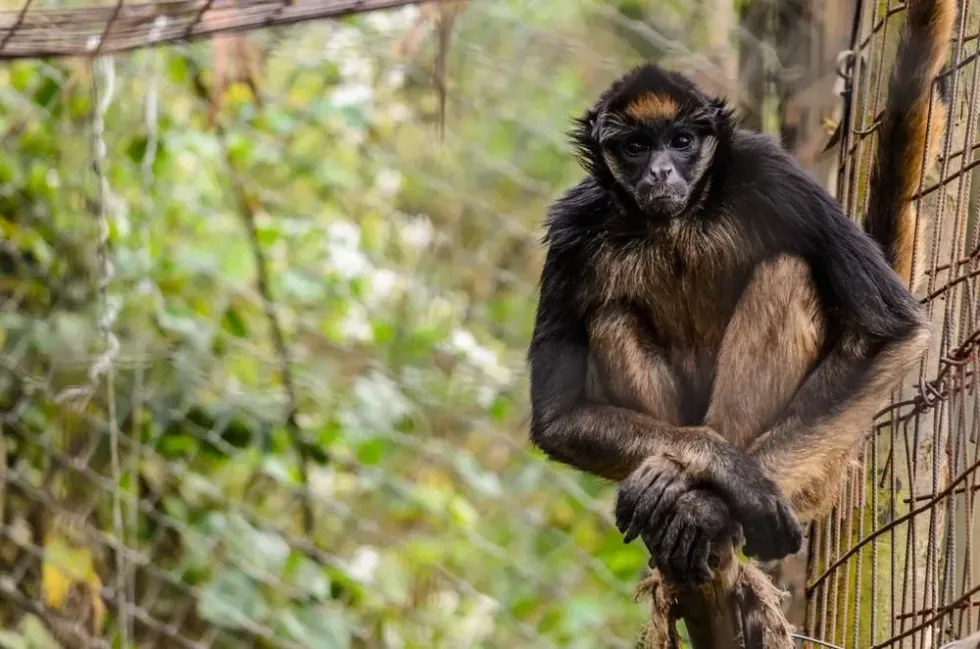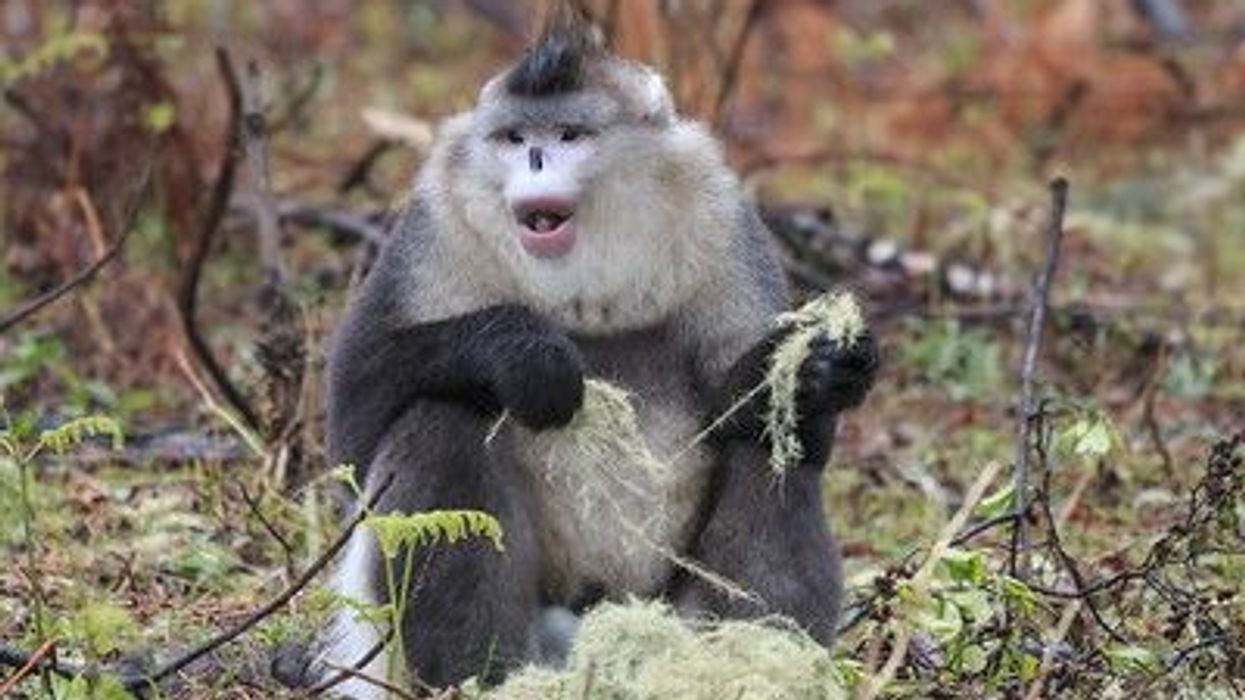White bellied spider monkeys (Ateles belzebuth) are primates and a species of spider monkey. They are also known as white fronted or long haired spider monkeys.
They are a type of New World monkey that lives in Mexico or South America today but has roots in the continent of Africa. Today they can be found in South America in tropical Amazonian forests.
Even though these monkeys' name suggests that they have white bellies, in actual fact their bellies are more of a yellowish cream color.
Unfortunately, these amazing creatures have a conservation status of Endangered. This means that if nothing is done to protect them, they could become extinct from the world forever.
Not only would we miss this stunning monkey species, but this would negatively impact our environment as they are vital for seed dispersal in the forest, allowing for more fruit trees to grow and thrive.
Learn more about the white bellied spider monkey with this article. The more you know, the more you can do to protect them!
If you are a fan of primates, why not read these articles about the woolly monkey and the patas monkey too?
White Bellied Spider Monkey Interesting Facts
What type of animal is a white bellied spider monkey?
The white bellied spider monkey (Ateles belzebuth) is a species of monkey.
What class of animal does a white bellied spider monkey belong to?
White bellied spider monkeys are mammals.
How many white bellied spider monkey are there in the world?
It is not known exactly how many white bellied spider monkeys there are in the world. However, it is clear that numbers of this species are decreasing.
Where does a white bellied spider monkey live?
You can find white bellied spider monkeys in forest habitats.
What is a white bellied spider monkey's habitat?
These monkeys are a species native to the northwestern Amazon in Peru, Venezuela, Brazil, Colombia, and Ecuador. They can be found as south as the lower Uyacali river and east towards the Branco river They spend the majority of their time in the forest canopy and very rarely go to the ground.
The Amazon forest is known for its rich biodiversity. It has forests, bamboo, flooded areas, and savannahs. The temperature is warm and moist.
Who do white bellied spider monkeys live with?
White bellied spider monkeys (Ateles belzebuth) live in groups (troops) with ranging from six to 25 other monkeys, sometimes even more. The group size depends on the environment as larger groups require a larger area of undisturbed forest.
White bellied spider monkeys have very interesting group dynamics. In the early hours before sunrise, usually from January to April, the group chooses to split up into smaller groups for foraging.
At night time, the whole group comes back together. Scientists call this kind of group formation 'fission fusion'. This fission fusion system makes them very effective at getting enough food for the group.
The smaller groups can be only males, only females, or a mix. Typically, females stay close to the home territory whereas males go a bit further out to find fruits. However, the female white bellied spider monkeys (Ateles belzebuth) in Yasuní national park, Ecuador, go as far from home as the males.
How long does a white bellied spider monkey live?
Spider monkeys can live up to 30 years of age in the wild and up to 40 years in captivity. Some scientists have discovered that females tend to live longer than males.
How do they reproduce?
Research has found that spider monkeys reach sexual maturity at four to five years old, the reproductive age for this species. From the age of five, males leave their family nest and start courting females to start reproduction. Interestingly, males prefer to court away from the prying eyes of their family and group. Females also mate with several partners.
Spider monkeys are reproductive throughout the whole year but give birth to one baby at a time. Like most animals, they have offspring through sexual reproduction. Mothers become pregnant after sexual intercourse when they reach sexual maturity and carry the baby in their belly.
What is their conservation status?
White bellied spider monkeys (Ateles belzebuth) have the conservation status Endangered, and the population of this species is continually decreasing.
White Bellied Spider Monkey Fun Facts
What do white bellied spider monkeys look like?
White bellied spider monkeys have a narrow face, tiny chin, and small snout. They have almond-shaped brown eyes and black fur covering most of their body, with yellow-cream fur on their bellies.
These primates have a long prehensile tail, a tail that is great for grabbing. Their tail is strong enough to hold their whole body weight and allows them to throw themselves between trees.
White bellied spider monkeys have long and muscular limbs. Their shoulders can completely rotate which helps them to swing through the trees. Their hands have long and thin fingers that help them to grip onto branches. They don't have thumbs though!

* Please note that this is an image of spider monkey babies, not a white bellied spider monkey specifically. If you have an image of a white bellied spider monkey, please let us know at hello@kidadl.com.
How cute are they?
These monkeys are very adorable. They are quite small and have beautiful big eyes.
How do they communicate?
These primates make noises and use body language to communicate. Groups make 'whinning' noises to identify each other.
Loud calls often alert other members of the group about intruders, a predator, or a threat. These monkeys are also known to shake branches to help scare aware any enemies. Young spider monkeys can also produce distress calls when separated from their mothers, or when lost or injured.
These animals have some almost human-like ways of communicating. They are known to hug and embrace each other. They also often groom each other.
These monkeys are also known to rub leaves on their bodies. Scientists are not completely sure why, but they suspect that the leaves act as a natural insect repellent or even that the leaves will signal the social status of the monkey and attract a partner.
How big is a white bellied spider monkey ?
White bellied spider monkeys are quite small in relation to other primates. Males and females are also slightly different in size.
The males' height range is 17–19 in (42-50 cm) tall and the females' height range is 13–23 in (34-59 cm) tall. Both males and females have a tail length ranging from 25–35 in (65-90cm). This is longer than their entire body!
How fast can a white bellied spider monkey jump?
White bellied spider monkeys don't really jump, they swing. They can cover great distances with just one swing. With just one powerful swoosh, they can move 30 ft (9 m).
How much does a white bellied spider monkey weigh?
These monkeys weigh between 13-20 lb (6-10 kg). That is roughly 10 times smaller than an average adult gorilla.
What are their male and female names of the species?
Females and males are both called white bellied spider monkeys.
What would you call a baby white bellied spider monkey ?
Baby monkeys are called infants. Females keep their offspring with them when they are tiny, even bringing them when they search for food. The babies are weaned once they reach 12-20 months.
What do they eat?
White bellied spider monkeys spend 20% of their time eating. That is a lot of eating! They feast on fruits, seeds, foliage, flowers, and buds. Their favorite tree species to eat are ficus, cecropia, borsnium and verola. They really enjoy eating the sweet fruit growing on these trees.
As these monkeys love fruit so much, they are great at seed dispersal making them very important for the forest and the environment. They consume fruit and transfer the seeds around the forest, allowing for more trees and plants to grow. Some of the seeds they spread also feed other animals such as mice.
How active are they?
They are quite active animals! These monkeys travel far from their nest to forage food. They have muscular limbs that help them to easily swing through the trees.
Would they make a good pet?
Although they are very cute, this species does not make good pets. In fact, in many places around the world owning a spider monkey as a pet is illegal. They are much better off in the wild, or in rehabilitation centers that work to protect their population.
Did you know...
Each white bellied spider monkey transfers 230,000 seeds a year, spread a distance of 600-3,900 ft (500-1,200 m) away from their home territory.
Males patrol the group and even fight off intruders. If you cross a male protecting his home he can bite you quite aggressively. A spider monkey acting aggressively can kill a human.
White bellied spider monkeys travel an average of 1-2 miles (1.5-3 km) every single day looking for food. Their foraging patterns and the distance traveled depends on which fruit trees are in season and where they are located in the forest.
This species has a matriarchal system meaning that females take the lead. Females choose their mate, they lead the group and make decisions. They are also more likely to leave the nest than a male once they reach puberty.
A group of white bellied spider monkeys is called a troop.
The conservation effort for these monkeys is challenging because they do not reproduce very often. After a gestation period lasting seven months, females give birth to one infant every two to four years.
Why is the white-bellied spider monkey endangered?
These animals are extremely vulnerable because of changes to their natural habitat. Deforestation has removed the trees which are their homes. As these primates are moved from their home, they are more likely to stay in smaller groups in less private areas of the forest. This can make them more vulnerable to poachers and hunters.
In fact, they have been so over-hunted that they have been completely removed from some areas, particularly in the lowland forests in the Peruvian Amazon.
Another reason that they are becoming endangered is because of climate change. Temperature increases have changed the fruit availability in the forest.
What are some fun facts about spider monkeys?
They are called 'ateles' which means 'imperfect', it is thought that this is because they do not have any thumbs.
They are called spider monkeys because when their limbs are clinging to branches, these monkeys look like spiders.
Predators of these spider monkeys include jaguars, eagles and pumas.
Sometimes, spider monkeys eat with their hands whilst their tail lets them hang from the trees!
Here at Kidadl, we have carefully created lots of interesting family-friendly animal facts for everyone to discover! Learn more about some other mammals including squirrel monkeys or the Proboscis monkey.
You can even occupy yourself at home by drawing one on our White Bellied Spider Monkey coloring pages.









